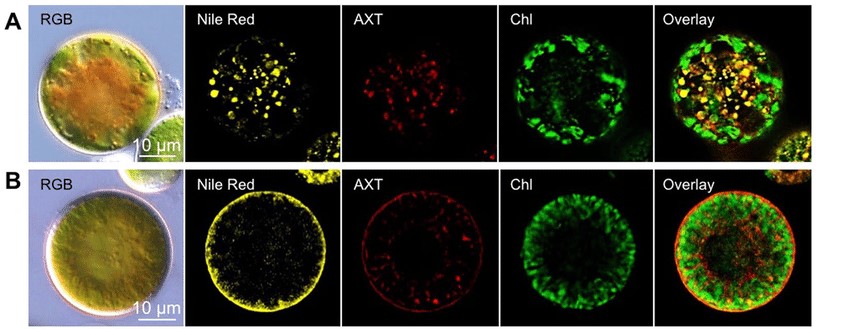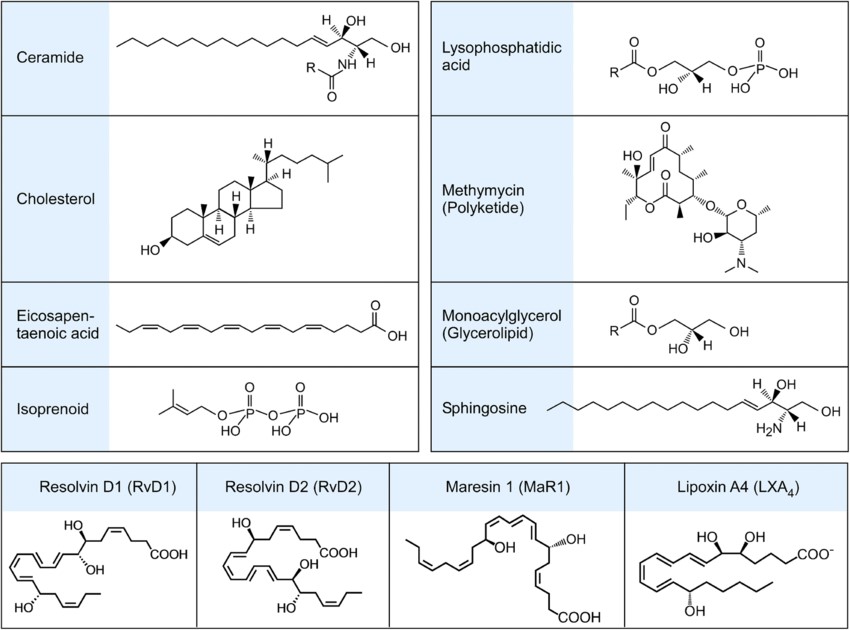Our Products Cannot Be Used As Medicines Directly For Personal Use.


Welcome! For price inquiries, please feel free to contact us through the form on the left side. We will get back to you as soon as possible.
Fluorescent Lipids & Bioactive Lipids
Lipids, as fundamental components of cellular membranes, play crucial roles in structural integrity, signal transduction, and energy storage. Among them, bioactive lipids represent a dynamic class of molecules involved in diverse biological processes, including inflammation, immunity, and apoptosis. Parallel to their physiological importance, fluorescent lipids have emerged as powerful tools for lipid research, enabling real-time visualization, tracking, and analysis of lipid behaviors in live-cell imaging.
At Creative Enzymes, we offer a comprehensive portfolio of fluorescent lipids and bioactive lipids to provide researchers and industry with cutting-edge solutions for lipid analysis, cellular imaging and functional studies. Utilizing precise synthesis technologies and rigorous quality standards, our products are designed to meet the demands of modern lipidomics, molecular biology, and therapeutic development.
Fluorescent Lipids: Visualize Lipid Dynamics with Precision
Fluorescent lipids are an advanced class of synthetic lipids conjugated to fluorescent dyes. These molecules are key pieces of the puzzle in lipidomics and molecular biology, allowing researchers to study lipid distribution, metabolism, and dynamics in cellular contexts. The fluorescent tags attached to these lipids can vary in wavelength and intensity, allowing multiplexed imaging in living or fixed cells.
Structurally, fluorescent lipids retain the basic configuration of native lipids—glycerophospholipids, sphingolipids, or sterols—while incorporating fluorescent moieties like BODIPY (boron-dipyrromethene), nitrobenzoxadiazole (NBD), or rhodamine. The chemical design ensures that the fluorescent moiety does not interfere with the natural functions of the lipid. For example, BODIPY-labeled fatty acids exhibit high photostability and minimal cytotoxicity, making them ideal candidates for studying fatty acid metabolism. In addition, NBD-based probes are widely used because of their small size and ability to localize lipid subpopulations.
 Figure 1: Structures of A: BODIPY; B: NBD; and C: rhodamine.
Figure 1: Structures of A: BODIPY; B: NBD; and C: rhodamine.
Fluorescent lipids enable high-resolution fluorescence microscopy techniques such as confocal, super-resolution, and fluorescence recovery after photobleaching (FRAP), which facilitate spatial and temporal lipid analysis. For example, fluorescently labeled phosphoinositides allow researchers to study lipid signaling pathways at the plasma membrane in real time, helping to understand cellular responses to external stimuli. Techniques such as fluorescence correlation spectroscopy (FCS) further quantify lipid dynamics and molecular interactions at nanoscale resolution.
 Figure 2: Fluorescence microscopy of lipid, astaxanthin, and chloroplasts. (A) Cell before light irradiation. (B) Cell after 10 min of light irradiation. Images are shown in the order: bright field (RGB), lipid fluorescence (Nile Red), astaxanthin autofluorescence (AXT), chloroplast autofluorescence (Chl), and overlay. (Ota et al., 2018)
Figure 2: Fluorescence microscopy of lipid, astaxanthin, and chloroplasts. (A) Cell before light irradiation. (B) Cell after 10 min of light irradiation. Images are shown in the order: bright field (RGB), lipid fluorescence (Nile Red), astaxanthin autofluorescence (AXT), chloroplast autofluorescence (Chl), and overlay. (Ota et al., 2018)
Applications of Fluorescent Lipids in Research
- Lipid Research: Fluorescent lipids are essential tools in lipid research, aiding studies of membrane biology, lipid trafficking, and metabolism. For example, fluorescent phosphatidylinositol derivatives reveal lipid-protein interactions during signal transduction, while fluorescent cholesterol analogs aid in the analysis of lipid raft domains that regulate signal transduction.
- Lipid Metabolism: In lipid metabolism, BODIPY-conjugated fatty acids visualize lipid uptake, transport, and degradation. Researchers use BODIPY-labeled palmitate to study β-oxidation pathways, providing insight into lipid utilization under normal and diseased conditions. In addition, fluorescent probes track lipid droplets to elucidate their role in metabolic diseases such as obesity and hepatic steatosis.
- Drug Discovery: In drug discovery, lipidomic imaging assays with fluorescent lipids enable high-throughput screening of compounds targeting lipid metabolism and signaling to identify therapeutic candidates for cancer, neurodegeneration and cardiovascular disease.
Bioactive Lipids: Unlock the Power of Lipid Signaling
Structure and Function of Bioactive Lipids
Bioactive lipids represent a distinct class of signaling molecules derived from lipid metabolism. In contrast to structural lipids, bioactive lipids exert potent biological activities at nanomolar to micromolar concentrations. Their small molecular size and amphipathic nature allow them to diffuse rapidly across membranes and act as intracellular and extracellular mediators.
The primary classes of bioactive lipids include eicosanoids, sphingolipids, glycerophospholipids, and lysophospholipids.
- Eicosanoids, such as prostaglandins and leukotrienes, are derived from arachidonic acid through enzymatic oxidation. These lipid mediators regulate inflammation, pain, and fever, and their dysregulation contributes to chronic inflammatory diseases and cancer. For example, prostaglandin E2 (PGE2) promotes tumor progression by modulating immune suppression and angiogenesis.
- Sphingolipids, another vital class of bioactive lipids, include sphingosine-1-phosphate (S1P) and ceramide. S1P acts as a critical signaling lipid in cellular proliferation, migration, and vascular development. Conversely, ceramide serves as a pro-apoptotic molecule, triggering cell death pathways under stress conditions. Dysregulation of sphingolipid metabolism is implicated in neurodegenerative disorders, including Alzheimer's and Parkinson's diseases.
- Lysophospholipids, such as lysophosphatidic acid (LPA) and lysophosphatidylcholine (LPC), mediate cellular functions ranging from proliferation to migration. For example, LPA receptors are highly expressed in tumors and regulate cancer cell invasion and metastasis. LPC also plays a role in inflammation and lipid-induced toxicity in cardiovascular disease.
 Figure 3: Structural diversity of key bioactive lipids. (Sulciner et al., 2018)
Figure 3: Structural diversity of key bioactive lipids. (Sulciner et al., 2018)
Applications of Bioactive Lipids in Research and Industry
- Cellular Signaling and Disease Research: Bioactive lipids, such as prostaglandins, sphingolipids, and lysophospholipids, are critical to the study of cell signaling pathways. Researchers are investigating their role in processes such as inflammation, apoptosis, and immune responses. For example, sphingosine-1-phosphate (S1P) is widely studied for its role in vascular development, cancer progression, and immune regulation.
- Pharmaceutical and Therapeutic Development: Industries are using bioactive lipids to develop drugs that target lipid pathways. For example, inhibitors of eicosanoid synthesis are used as anti-inflammatory agents, while S1P receptor modulators are used in therapies for multiple sclerosis and other autoimmune diseases.
- Biomarker Discovery: Bioactive lipids serve as biomarkers for several diseases, including metabolic syndrome, cardiovascular disease and cancer. Lipidomic profiling helps to identify changes in lipid mediators for diagnostic and therapeutic applications.
- Cosmetic and Personal Care Industry: In the cosmetics industry, bioactive lipids such as ceramides and fatty acids are incorporated into skin care products to improve barrier function, hydration and anti-aging properties to address dermatological conditions such as dry skin and eczema.
- Nutraceutical and Functional Food Industry: Bioactive lipids such as omega-3 fatty acids and phytosterols are used in nutraceuticals to promote heart health, reduce inflammation, and improve cognitive function. These lipids are incorporated into dietary supplements and functional foods for therapeutic benefits.

Discover how our fluorescent lipids and bioactive lipids can drive breakthroughs in lipidomics, cellular signaling, and therapeutic development. Whether you are mapping lipid dynamics or targeting lipid-mediated pathways in disease, Creative Enzymes delivers the innovative tools you need to succeed. Contact us to learn more, request a quote, or explore customized solutions for your research.
References:
- Ota S, Morita A, Ohnuki S, et al. Carotenoid dynamics and lipid droplet containing astaxanthin in response to light in the green alga Haematococcus pluvialis. Sci Rep. 2018;8(1):5617.
- Sulciner ML, Gartung A, Gilligan MM, Serhan CN, Panigrahy D. Targeting lipid mediators in cancer biology. Cancer Metastasis Rev. 2018;37(2-3):557-572.